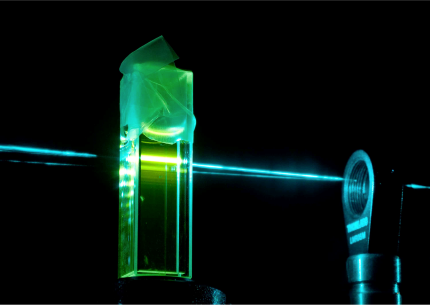The origin of UV photoprotection in melanin

Image of a fluorescent sample being excited by ultrafast laser. Photo VUW Image Services.
Posted: Thu, 3 Nov 2016
Eumelanin (a type of melanin) is the natural brown skin pigment that protects us from sunburn. It forms ‘nano-assemblies’ that efficiently absorb UV radiation and disperse the energy as heat, protecting our skin from the damaging effects of sunlight.
So how does eumelanin do this so efficiently? We don’t yet know, because these nano-assembly mechanisms are so chemically and physically complex.
Associate Professor Justin Hodgkiss from the School of Chemical and Physical Sciences at Victoria University of Wellington and Professor Paul Meredith from University of Queensland have received a Marsden Fund grant to explore how eumelanin works.
The researchers will use a combination of three ultrafast broadband methods, using sophisticated high-speed lasers, to watch how eumelanin absorbs and dissipates energy. This happens on timescales as short as femtoseconds (one millionth of a billionth of a second).
Beyond answering the main question of how eumelanin protects us from UV light, they will gain insight into how it regulates other photobiological processes. For example, sunburn, melanoma, wrinkling, and vitamin D production all have slightly different UV responses, and are thus affected by different parts of eumelanin’s absorption spectrum.
This knowledge may guide the design of new optical components and sunscreens, and may later be applied to a host of other biomaterials that undergo UV photochemistry.

Associate Professor Justin Hodgkiss, Victoria University of Wellington
Total Funding: $870,000 (excl. GST) over 3 years
Researchers: Dr Justin Hodgkiss, School of Chemical and Physical Sciences, Victoria University of Wellington, PO Box 600, Wellington 6140
